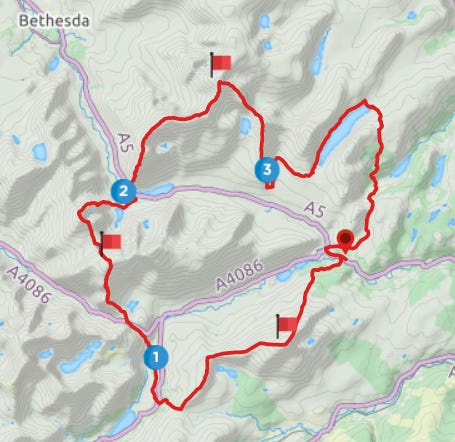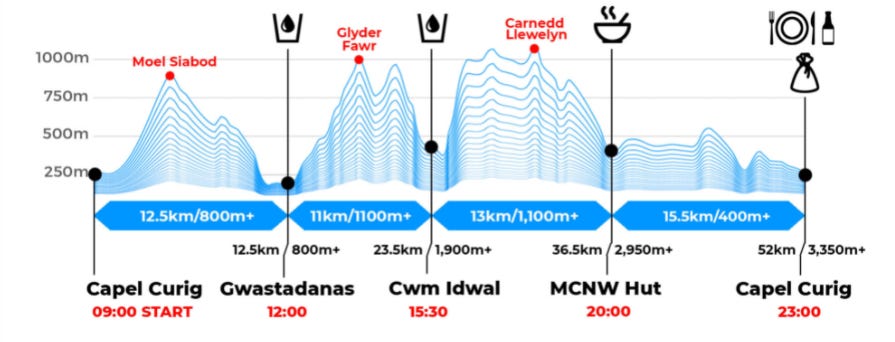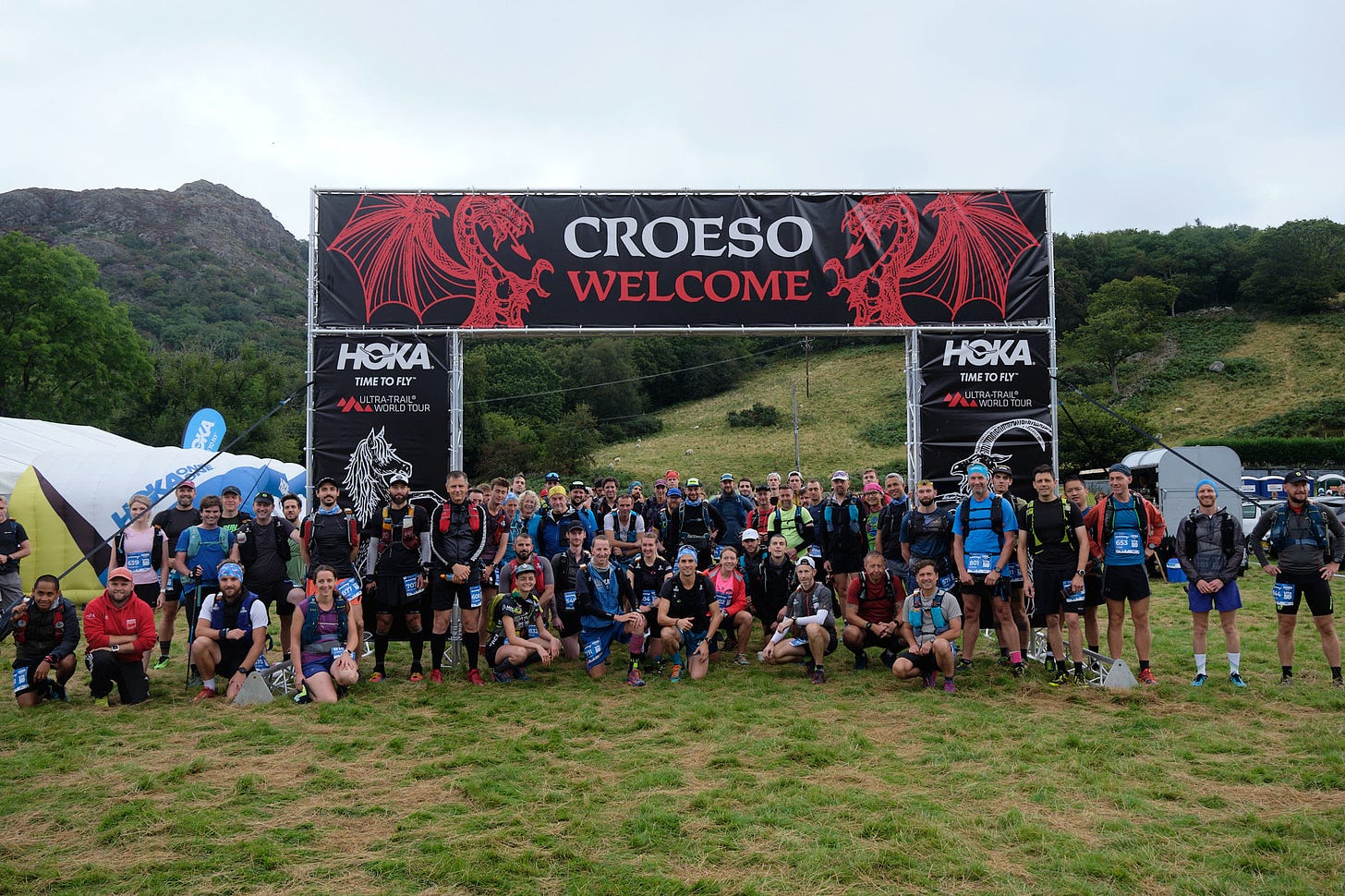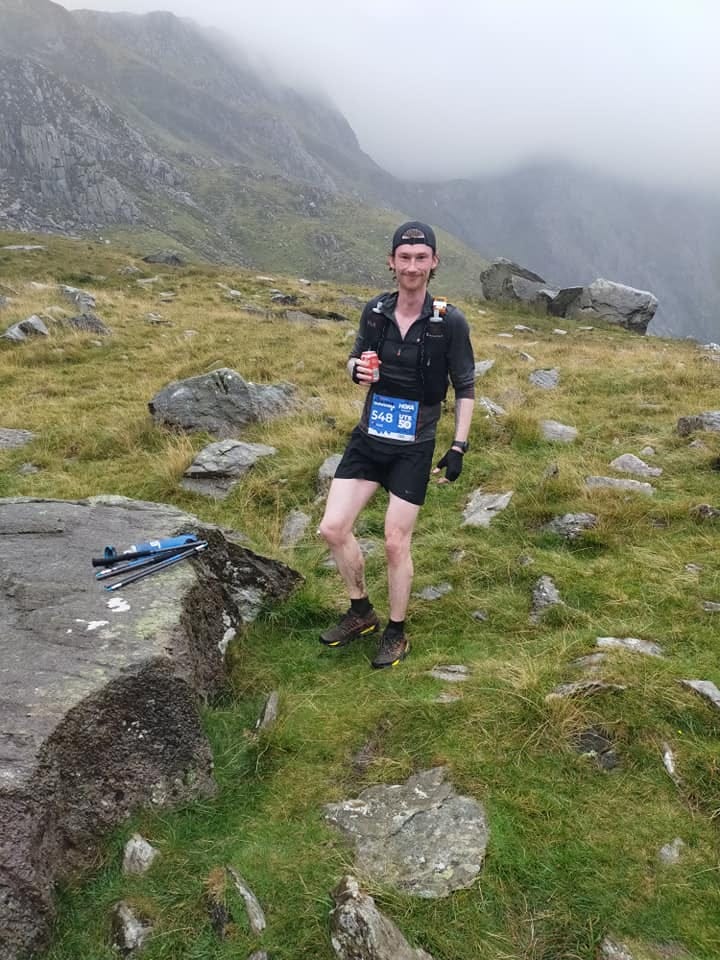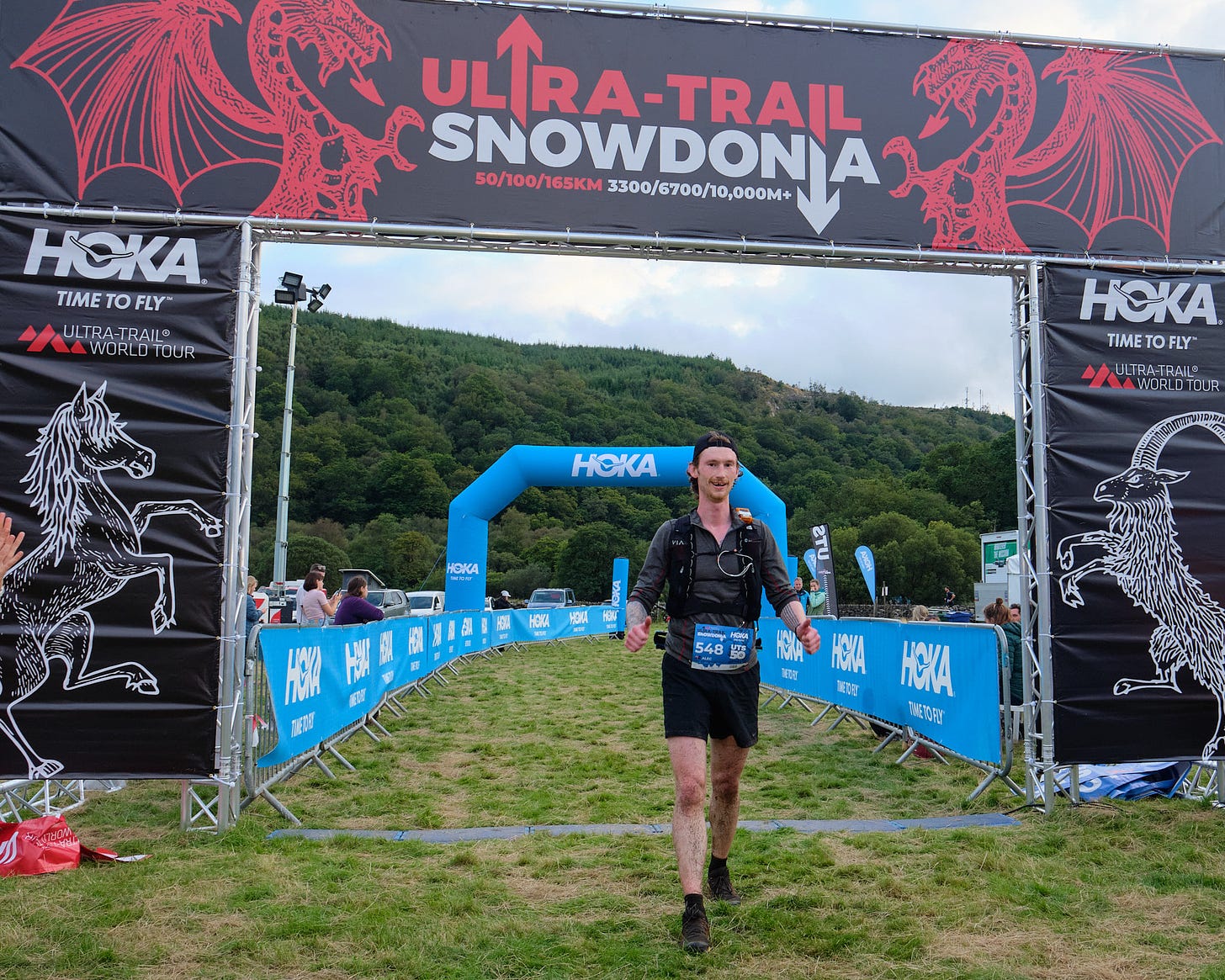Written by Alec Burns - https://uphillalec.substack.com/
Location: Capel Curig, Wales
Time/Date: 9am, 11 September 2021
Distance: 50.38km (by my watch)
Elevation Gain: 3,438m/11,279ft (by my watch)
For my first ultra distance race, and in fact first race of any description since a brief foray into running back in 2018, I couldn’t have picked a better one than Ultra Trail Snowdonia. “Beautiful beyond belief. Savage beyond reason” is the tagline, and it fits.
After a 2 year gap since my 6 month running career in 2018, I got back onto the trails in November of 2020. Originally signed up for a much flatter 50k in the Peak District, my enthusiasm outpaced my body and I went down with an overuse injury in March, keeping me out until early July in terms of meaningful training.
The obvious thing to do when recovering from injury is to sign up for what must be one of the UK’s, if not Europe’s most difficult 50k races, especially when you’ve only about 8 weeks left to train before tapering. But, Snowdonia has become maybe my favourite place in the UK since moving here from Australia and I couldn’t resist.
Based on my recce runs, I aimed to finish in under 10 hours, which represented what would be a very good day out. Ambitiously, I thought that if I had a flawless day, and everything (including what I couldn’t control) fell perfectly into place, that under 9 hours was possible.
Preparation
Arriving in Snowdonia on the Friday before race day Saturday, I went through the kit check, picked up my number and GPS tracker, all very smoothly handled by the excellent team of volunteers at race HQ. Having already received the briefing in the form of the race handbook via email, all that was left to do was turn up for the start in the morning. We went for a nice pub dinner in Anglesey, and I very responsibly did not have a beer.
Admittedly in the morning the nerves were starting to kick in. Arriving in the car park up the road from the start line, I quickly hopped out and started my final bits of prep, more in need of an outlet for nervous energy than anything else. I even put sunscreen on, with the forecast having said there was a chance it would clear up and be sunnier in the afternoon (it was not).
I joined the crowd milling around race HQ, most giving off the same quiet, expectant energy ahead of what I’m sure everyone knew was going to be a long and challenging day. There was a quick group photo then we all moved up to the starting area across the road from the Moel Siabod Cafe (thoughtfully positioned there to avoid 300-ish runners immediately crossing a busy road). Another few tension-laden minutes of waiting later, race director Michael Jones counted us down and off we went.
Start to CP1
The course began with a short, but runnable incline on a wide, gravel road that gradually narrows until reaching a stile as the course turned more decidedly uphill, which signalled when mortals should probably commence hiking. I ended up quite near the front in the starting area, so happily let people pass me along this section as I maintained not much more than a gentle jog.
Once through the stile the poles were out and I joined the conga line making its way up Moel Siabod. We had almost perfect running weather at this stage and throughout; overcast, decent breeze, with the occasional bit of drizzle and a temperature not much higher than about 15 degrees.
The climb up Moel Siabod isn’t ridiculous compared to the other mountains of Snowdonia. The path is relatively clear, not technical and gradual enough to maintain a good hike on.
Trying to keep a lid on my effort level early on I fell in with a small group and chatted on the way up, talking about what we knew about the course ahead and other events run in the past. As an Australian I got all the predictable questions once they heard the accent, which I don’t at all mind answering and makes the conversation easy when the alternative is to think about how hard Pen Yr Ole Wen is going to be.
As we neared the summit the low cloud closed in around us and we became a little more reliant on the orange way markers to make sure we weren’t drifting. Having been up there a couple of times before I recognised the approach to the cairn and looking at my watch realised I was already 10 minutes up on schedule. I chalked it up to an excited start, extra freshness in the legs from tapering and not losing time on nav checks as I had on the recce.
As with most climbs, this was followed by the descent. The course down the North-Western side of Moel Siabod is temptingly runnable, being mostly short grass with just the occasional rocky patch. Ian Corless was here taking photos, so I was careful to look confident skipping over the rocks as I passed him to avoid ending up on a blooper reel. Following a fenceline down and through a couple of stiles, I very deliberately took it easy in hope of saving my legs for the mountains to come.
There was only one brief little climb on this section, interspersed with slightly more technical sections and occasional bog. If I have a running specialty, it’s probably technical descents, and I managed to pass quite a few people when the terrain got a bit rougher. This was a nice confidence boost, even though a fair few cruised back past me on the road leading into CP1.
I went through CP1 (~12.5km) in 1hr45min, 15 minutes faster than planned. At this stage I was happy with that, although I was aware that it likely signalled I was going a bit quick so early in the race.
CP1 to Glyder Fawr, Y Garn, CP2
Already well ahead of schedule, I walked the entire way up to Pen-Y-Pass, most of which I had walked on my recce anyway. Much like Moel Siabod, this section is all on a very clear and relatively gradual path that allows for good hiking speed without a huge effort. I saved my legs for Glyder Fawr.
Once across the road at the youth hostel, the climb up Glyder Fawr begins immediately and feels much more serious than Moel Siabod. The path is far less well trodden (in some parts non-existent) and in places a scramble over rocky outcrops.
I knew what lay ahead so just kept a steady hiking pace and chipped away at it. I got talking to an Irish guy with a road running background, he hadn’t recce’d the course so I gave him a warning about Pen Yr Ole Wen, saying my strategy was to keep the effort level low until I was past that climb, being in my opinion the toughest section.
It was on the way up Glyder Fawr that it felt like Ultra Trail Snowdonia had really started after the warm up on Moel Siabod. It’s steep, quite technical in places and hard to avoid the effort level rising. Checking the elevation on my watch it seemed I was stuck at 600-something metres for a long time.
As we got into the last third of the climb I had started gaining on a small cluster of runners ahead, managing to sneak up through the low cloud and pass them one by one before the summit. Another nice little confidence boost, but perhaps effort that would have been better saved for later in the race as I could already feel faint twinges in my quads, hinting that cramping might occur sooner rather than later. I reached the top in 3hrs5min, 30 or so minutes faster than planned, which set off a little alarm bell about pacing.
Lack of experience, and my enjoyment of descending however, won out over common sense. I let myself pick up a bit of speed coming down the scree on the other side, passing another couple of runners and just generally having a good time hopping from rock to rock and doing imitation ski turns in the loose gravel. I did slow right down and walk across to Y Garn though, giving my legs a break before whipping the poles back out for the climb.
The approach to Y Garn from Glyder Fawr is not at all technical or particularly steep, you just walk straight up it, making it tough in its own way because there’s no excuses for not keeping a decent pace. I did note that in the poor visibility the route had been altered slightly to follow the left hand path to the top, rather than the one that skirts the Eastern edge above a more or less vertical face.
The course then followed the well trodden path down to Llyn Idwal and CP2. Very steep and technical in places, especially with just the right amount of drizzle to make every rock a slippery death trap. This section really hammers the quads as you come down the big stone staircase, so I didn’t rush and happily jogged into CP2. The view coming down this part is stunning on a clear day, but I wasn’t bemoaning the layer of cloud keeping conditions cooler.
I got into CP2 (~24km) in just under 4 hours, way up on schedule (I had allowed up to 4 hours just to reach the top of Glyder Fawr) and feeling good. I had planned to reach this point with plenty left in tank, but the little twinges in my quads on the climb up Glyder Fawr were concerning. I took a 7 minute break here, refilled my water and received a welcome can of coke from my highly professional crew (my endlessly patient fiancee).
CP2 to Pen Yr Ole Wen Summit
I was excited for, and dreading Pen Yr Ole Wen in equal parts. The most challenging climb of the race, gaining 700m in elevation over roughly a mile of the most technical terrain on the course. It involves sections of scrambling with some exposure, which I enjoyed but my legs did not. Headphones with my special UTS playlist went in. I felt like I might need some encouragement in the form of Parkway Drive, and I was correct.
Not much more than 10 minutes into the near vertical ascent the cramps in my quads were well and truly kicking in. I was honestly surprised at the severity given how good I had been feeling in CP2, and having drunk plenty of water and taken numerous salt tablets by this stage. There was nothing to be done about it, I just kept moving and let the cramping happen. They faded in and out but didn’t seem to be worsening, and after an eternity the ground levelled off and the climb was done. Somehow I got up it in 1hr8min, 2 minutes faster than planned.
Pen Yr Ole Wen to CP3
The strategy was always to use the stretch from Pen Yr Ole Wen to Carnedd Llewelyn as a rest. I knew I would be knackered after the final ‘big’ climb of the race, so especially after my 1 hour cramp-a-thon I backed right off, taking time to eat and drink as I made my way over the Carneddau.
On fresher legs, this can be a fast section as it’s largely flat and runnable. There are a few bits that are rocky enough to slow you down, but I had made it from the Pen Yr Ole Wen summit to the top of Carnedd Llewelyn in well under an hour on my recce. That was not the case for me during the race however, as I mixed walking with shuffling depending on how bad the cramping was.
The group that had tailed me up Pen Yr Ole Wen had long since made their way off into the mist and I spent this entire section on my own. I generally prefer running on my own, and it was particularly welcome at this point as it meant I could cramp-waddle shamelessly.
On the day, visibility was especially poor and I was grateful for my OS Maps subscription. While the course marking was excellent, it’s easy to drift on the more open sections while you pick your way through the rocks. But, with half a flapjack in one hand and iPhone in the other I worked it out. Nav is easier when you’re not moving very fast anyway.
Neither of the climbs up Carnedd Dafydd or Carnedd Llewelyn are especially difficult in isolation despite the loose, rocky terrain, but with 30-ish kilometres and the best part of 3,000m of ascent already in the legs they were slow going. I started kicking rocks more and more often as my feet dragged, and each slip on a loose rock risked triggering another spasm in my quads.
Finally coming down out of the cloud I spotted a couple of runners on their way toward Pen Yr Helgi Du. I had the cramping under control (not really) so risked a light jog down and across the rocky sections that precede the scramble up. Pen Yr Helgi Du from this approach is a very short, but very technical ascent that really falls into the category of bouldering more than it does any form of running. Having caught up the runners ahead we briefly joined forces to spot the markers showing the correct path to the top.
Checking my watch I saw that I could still reach CP3 (~35km) in under 7 hours, my final benchmark for a sub-9 hour finish. I knew at this point, with my legs in the state that they were, that under 9 hours was not happening, but there was a glimmer of hope. ‘The damage is done’, I told myself, ‘going slow will hurt just as much as going fast’, so I bombed the whole way off Pen Yr Helgi Du.
With my heels nearly hitting the back of my head, flying past the mountain ponies, legs screaming the whole way down the grassy slope, I arrived at the final aid station in 6hrs56min, which at the time felt a triumphant victory. The outstanding volunteers refilled my soft flasks, gave me a bag of crisps and pointed me in the direction of the final 15km stretch to the finish.
CP3 to Finish
This section starts by contouring around to the South of Pen Y Llithrig Wrach on a mercifully flat gravel road. This was a mix of walking and shuffling for me dependent on cramp intensity despite having envisioned being able to sustain a healthy run in my race planning.
This being the only part of the course I hadn’t seen before, I naively thought the next part of the route around the reservoir might be a nice, well maintained path. In what I suppose is not a huge shock, it was not.
Coming off the gravel road, there was definitely a path, but much more undulating and certainly rougher than I had hoped. Progress became more stop-start as I alternated between running until my quads cramped up, then stretching them out, but progress is progress. I finally relinquished hopes of finishing in under 9 hours, and focused on maintaining momentum.
The time spent going along the edge of the reservoir did however serve up the best views of the day, with cloud having obscured them from higher up. It was a gorgeous bit of trail with mountains either side, made all the more enjoyable by knowing the hardest work was behind me and my sub-10hr goal time was safe.
Coming around the Northern end of the reservoir and heading East there was a little climb then a nice gentle descent into the forest, the path winding downhill through the trees which was a nice change of scenery. My legs were still a nightmare but finish line fever was creeping in and proved to be a reasonably effective painkiller. During this section I went up to my waist in a bog, which I couldn’t help but find pretty funny at that point. I dragged myself out, quite satisfied that the mud would add to the hardcore mountain runner aesthetic.
After the final tiny hill it was all downhill from there and mercifully the cramps finally subsided. I was caught up by a guy who much like me had only started running ultras this year, who confirmed that this race was much harder than some of the other ultras he had tried. We had a quick chat about the merits of various brands of trail running shoes, and I gave it a final push down to the road through Capel Curig.
That stretch of road can’t be much more than about 400 metres, but seemed to last forever. The applause from earlier finishers on their way back to the car park was much appreciated, but I couldn’t muster much more than a thumbs up to show it. And then, finally, past the Moel Siabod Cafe, through the gate, and over the finish line in 9 hours and 49 minutes.
Thank you to all involved in organising. It was brilliantly run throughout, I unreservedly recommend this race to anyone who fancies the challenge. The amazing staff in the aid stations were helpful and efficient, the course was extremely well marked considering the terrain, from my perspective as a runner it couldn’t have been better.
Gear
Shoes: La Sportiva Mutants
These worked really well for me in training including both recce runs (in dry conditions), and were comfortable throughout. They are certainly robust if a bit clunky, the grip is beyond reproach on softer surfaces. However, I did have a few slips on wet rock, potentially owing to the existing wear on the outsole. If I could do it over (and I intend to), I would probably opt for a shoe with shallower lugs and more surface area to better handle the rocks which make up the sketchier parts of the course, something like a VJ XTRM (which I saw a fair few pairs of on other runners).
Pack: Montane Gecko VP 12+
I previously held up the Salomon ADV Skin packs as the gold standard having used one back in 2018, and had been using the new 5L version in training until the back compartment suffered a catastrophic blow out resulting in the loss of various bits of kit. In a rage I bought the Montane pack and it was a great decision. The fit is amazing, it barely moves even when fully loaded, and has all the storage where you want it (including zippered pockets for items you don’t want to risk bouncing out).
The mandatory kit list was the same for all UTS distances up to the 100 miler, and the pack fit everything in with room to spare. I also wore the Compressport free belt pro, but only for the elastic loops to carry my poles when folded.
Poles: Black Diamond Carbon Z
I’ve only ever used one set of poles so I don’t have a frame of reference for comparison, but they did the job, and there were definitely times when they were picking up the slack. When folded up and stowed away they’re light enough that I didn’t notice they were there. I did see a lot of Lekis on the course though, which suggests they’re an equally good choice.
Watch: Coros Apex 46mm
A relatively recent purchase as I didn’t trust my ancient Garmin forerunner to last potentially 10hrs+. In 9hrs49min of full GPS and navigation mode it used just 23% of the battery life. As the course was so well marked, the navigation mode was really just a failsafe, but was worthwhile as it did prompt me to double check my position on the OS Maps app when visibility was exceptionally poor. The built-in altimeter was also helpful for knowing how far up a climb I was when cloud obscured the summit. For the price I don’t think there’s a better watch out there for this kind of race.


